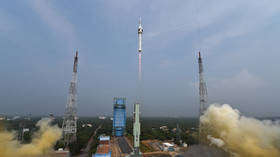India to launch dozens of satellites to mitigate ‘threats’ along borders

India is planning to create a layer of satellites in different orbits capable of tracking the movement of troops and photographing thousands of kilometers along the borders with neighbors China and Pakistan, the head of the Indian Space Research Organization (ISRO) announced on Thursday, according to the PTI news agency.
Speaking at an event at the Indian Institute of Technology-Bombay, Sreedhara Panicker Somanath noted that launching satellites on a larger scale could mitigate threats from the border areas.
“We have been launching satellites to handle this, but there is a different way of thinking now and we need to look at it in a much more critical manner because the power of [any] nation is the ability to understand what is happening around it,“ Somanath said, according to PTI. He added that 50 satellites have already been configured for developing geo-intelligence capability and could be launched in the next five years.
India needs ten-times more satellites than the 54 it has at present if it is to become a “strong nation,” Somanath insisted. He added that it was also important to improve the capacity of satellites in order to detect changes along the borders and integrate an AI-related and data-driven approach into analyzing data and to parse only essential information.
While explaining how a network can be established, Somanath said “we have found out a way by which a layer of satellites can be launched starting from GEO [geostationary equatorial orbit] to LEO [lower earth orbit] and also [in] very low earth orbit where we need a very critical assessment of some situation.” By establishing communication between these satellites, he explained, the country can more effectively track activities in strategically vital areas.
The space agency is set to begin the new year with the launch of the PSLV-C58 X-ray Polarimeter Satellite (XPoSat) space observatory on January 1 from the Satish Dhawan Space Centre in Sriharikota Island on the Bay of Bengal. XPoSat is India’s first polarimetry mission, which seeks to study bright astronomical X-ray sources in extreme conditions.
The satellite, along with ten other payloads, will be launched by ISRO’s Polar Satellite Launch Vehicle. “The mission’s objectives include measuring X-ray polarization and conducting long-term spectral and temporal studies of cosmic X-ray sources,” an agency official told Times of India newspaper.
In 2023, ISRO launched several breakthrough missions, including the Chandrayaan-3 probe to the Moon’s south pole in August and the Aditya-L1 mission to the Sun in September. In October, Indian Prime Minister Narendra Modi set new goals for the agency of setting up a space station by 2035 and sending the first Indian to the Moon by 2040.
Where India Meets Russia – We are now on WhatsApp! Follow and share RT India in English and in Hindi













